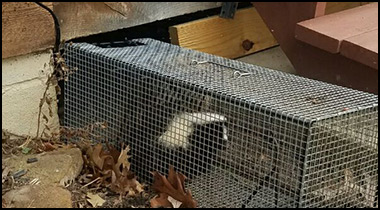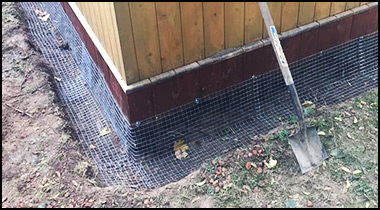Boston Skunk Removal Resources
Skunk Rehabber - New England Wildlife Center: (781) 682-4878
Free Suffolk County Animal Services: (617) 349-4376
Humane Wildlife Trappers of Boston: 617-939-9710
If you need skunk control in Boston, you have a few options. First, you can attempt to solve the skunk problem yourself by reading our do-it-yourself guide. If you need outside help, you can also call Suffolk County Animal Services to see if they have any free resources or help for you - however, they primarily deal with dog and cat concerns. You can also call a local Boston wildlife rehabber, as they are typically a great resource for advice that is in the best welfare of the animal. If as a last resort you must hire a professional company, we recommend Humane Wildlife Trappers of Boston at 617-939-9710. To learn more about them or check their skunk removal prices, visit bostonpestanimal.com.

Boston Skunk Trapping and Removal

Preventative Repairs & Exclusion

Boston Skunk Removal From Structures
In many cases, preventative measures can solve your Boston skunk problem - keep garbage secured, pet food indoors, and most of all when it comes to skunks, secure the perimeter of your shed, porch, deck, or house with a barrier - lattice or steel mesh is good, and it keeps Massachusetts skunks from going under the structure. If trapping and removal of the skunk is the only option you have, please do so with the help of a local agency or professional company who knows how to do it humanely and legally. Browse the resources of this site for more educational information.
Frequently Asked Questions:
Prevention: How to Keep Skunks Away
What to do with a skunk after I catch it?
Is it legal for me to trap a skunk?
How to remove skunk odor
Is a skunk active during the daytime rabid?
What does skunk feces look like?
Boston Skunk Control Information: How to find and remove a dead skunk
Animals seem to find their way into and under your house at year round, wether you live in the city, or in a rural area. These creatures are usually searching for food, water and a safe place to nest. Skunks are especially bad about making the underside of your house their nursery because of its relative seclusion. Unfortunately, Skunks occasionally die in or around your home, due to illness, traps, or natural causes. Skunks can fit in very inconvenient spaces like ventilation shafts, under steps, or inside walls. A skunk can cause quite a stink if it is rotting under your porch or inside an exterior wall. Finding and removing the body is paramount because if you can smell it, so can bugs and scavengers. And a can spread diseases or parasites, or attract bugs and other carrion feeders. Here is a guideline to safely locate and remove a skunk carcass from inside your home.
Make sure you have the right tools! Most skunks carry parasites and diseases when alive. The same can be true after death. Don't breathe over their dead body or touch it with your bare hands! Always wear a breathing mask and goggles. Be sure to use disposable gloves. If a carcass has begun to smell, it is mostly likely become "squishy". Protective wear will keep any juices out of your eyes and mouth. Have disinfectant like bleach, and an odor remover, bug spray, paper towels, rags, and plastic bags ready.
First, find the source- If you set traps, look there. If you laid out poison, look towards the nearest source of water. If you know the location of a nest, check that too. Follow your nose! If the smell is most powerful in the heat of the day, check your attic or basement first. If it is only one room, start sniffing the walls. A breeze will carry the odors around, so the most concentrated area of smell is not always the body, but close. If the strongest concentration r is in an open area like an attic or basement, carefully look through all insulation, containers, and under large objects. If it is a closed in area like a crawl space or passage between walls, sniff until you locate the most powerful stench. If it is inside the wall, you will need to cut a hole.
No matter where you find the body(s) spray for bugs and disinfect the area. If it already smells, you will find maggots carefully remove the body and seal it in a plastic bag for disposal. Spray the affected area again with the disinfectant and odor remover. Wipe the affected area with paper towels to remove any secretions or mess left behind, and then uses disposable rags to scrub the area. Remove and dispose of any soft" surfaces the creature died on that cannot be cleaned. Dispose of the bodies properly to avoid causing harm or illness to any person or creature that could come in contact with the carcass
Remember, for free services you can try (781) 682-4878 or (617) 349-4376, but if you need to pay for professional help, check the prices at the bostonpestanimal.com website. Or follow our do-it-yourself guide!

